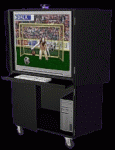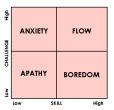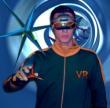Dec 29, 2004
Charles Tart: Virtual Reality & Altered States of Consciousness
The link between VR and altered states of consciousness is an interesting one. One of the first researchers that have discussed this relationship is Charles Tart. According to Tart, VR can be considered a new technological model of consciousness. In particular, he suggests that "stable patterns, stabilized systems of these internal virtual realities, constitute states of consciousness, our ordinary personality, and multiple personalities"
Of particular interest is Tart's explanation of the feeling of being "present" in a computer-generated world, although in its article he doesn't use the word presence. He suggests that presence emerges from a core psychological pattern which "automatically organizes the rest of experience around itself in a way that further supports the basic pattern". He thinks that this is the same process of perceiving a constellation. A constallation is not "real", because the spatial distribution of visible stars is random. However, once a pattern has organized, it is hard not to perceive it that way.
If you want to read more about Tart's theory of virtual reality, read these online articles:
Multiple Personality, Altered States and Virtual Reality: The World Simulation Process Approach
(This is the published version of the paper, which appeared as "Multiple Personality, Altered States and Virtual Reality: The World Simulation Process Approach" in the journal, "Dissociation," Vol. 3, 222-233)
Mind Embodied! Computer-Generated Virtual Reality as a New, Dualistic-Interactive Model for Transpersonal Psychology
(Based on a speech given at the L. E. Rhine Centenary Conference on Cultivating Consciousness for Enhancing Human Potential, Wellness and Healing, Durham, North Carolina, November 9, 1991. A modified version was later published in K. Rao (Editor), "Cultivating Consciousness: Enhancing Human Potential, Wellness and Healing." Westport, Connecticut: Praeger, 1993. Pp. 123-137.)
02:15 Posted in Telepresence & virtual presence | Permalink | Comments (0) | Tags: Positive Technology, Presence
Dec 28, 2004
Invited speech about Ambient Intelligence in Haifa
We have been invited by the Center for the Study of Information Society (Haifa, Israel) to present our framework about Ambient Intelligence.
The title of our presentation is: Ambient Intelligence: Conceptual and Practical Issues
More information can be found here:
http://infosoc.haifa.ac.il/events.htm
19:00 Posted in Positive Technology events | Permalink | Comments (0)
Dec 23, 2004
Presence 13:5 Now Available
The first journal for serious investigators of teleoperators and virtual environments, incorporating perspectives from physics to philosophy. 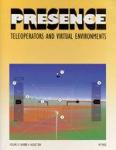 Vol. 13, Issue 5 - October 2004 Articles Article available as PDFSAMPLE ARTICLE - FREELY AVAILABLE!The Role of Graphical Feedback About Self-Movement when Receiving Objects in an Augmented Environment Andrea H. Mason and Christine L. MacKenzie Haptic Interfaces for Wheelchair Navigation in the Built Environment Colin S. Harrison, Mike Grant and Bernard A. Conway Exploring the Roles of Information in the Manual Control of Vehicular Locomotion: From Kinematics and Dynamics to Cybernetics Max Mulder, René van Paassen and Erwin Boer The Importance of Stereo and Eye Coupled Perspective for Eye-Hand Coordination in Fish Tank VR Roland Arsenault and Colin Ware Does the Quality of the Computer Graphics Matter when Judging Distances in Visually Immersive Environments? William B. Thompson, Peter Willemsen, Amy A. Gooch, Sarah H. Creem-Regehr, Jack M. Loomis and Andrew C. Beall Limited Field of View of Head-Mounted Displays Is Not the Cause of Distance Underestimation in Virtual Environments Joshua M. Knapp and Jack M. Loomis An Independent Visual Background Reduced Simulator Sickness in a Driving Simulator Henry Been-Lirn Duh, Donald E. Parker and Thomas A. Furness Toward Systematic Control of Cybersickness Marshall B. Jones, Robert S. Kennedy and Kay M. Stanney Postural Responses to Two Technologies for Generating Optical Flow Thomas A. Stoffregen, Benoît G. Bardy, Omar A. Merhi and Olivier Oullier [ More on Vol. 13, Issue 5 - October 2004 | Presence: Teleoperators and Virtual Environments Home Page | Presence: Teleoperators and Virtual Environments Orders and Renewals ]
Vol. 13, Issue 5 - October 2004 Articles Article available as PDFSAMPLE ARTICLE - FREELY AVAILABLE!The Role of Graphical Feedback About Self-Movement when Receiving Objects in an Augmented Environment Andrea H. Mason and Christine L. MacKenzie Haptic Interfaces for Wheelchair Navigation in the Built Environment Colin S. Harrison, Mike Grant and Bernard A. Conway Exploring the Roles of Information in the Manual Control of Vehicular Locomotion: From Kinematics and Dynamics to Cybernetics Max Mulder, René van Paassen and Erwin Boer The Importance of Stereo and Eye Coupled Perspective for Eye-Hand Coordination in Fish Tank VR Roland Arsenault and Colin Ware Does the Quality of the Computer Graphics Matter when Judging Distances in Visually Immersive Environments? William B. Thompson, Peter Willemsen, Amy A. Gooch, Sarah H. Creem-Regehr, Jack M. Loomis and Andrew C. Beall Limited Field of View of Head-Mounted Displays Is Not the Cause of Distance Underestimation in Virtual Environments Joshua M. Knapp and Jack M. Loomis An Independent Visual Background Reduced Simulator Sickness in a Driving Simulator Henry Been-Lirn Duh, Donald E. Parker and Thomas A. Furness Toward Systematic Control of Cybersickness Marshall B. Jones, Robert S. Kennedy and Kay M. Stanney Postural Responses to Two Technologies for Generating Optical Flow Thomas A. Stoffregen, Benoît G. Bardy, Omar A. Merhi and Olivier Oullier [ More on Vol. 13, Issue 5 - October 2004 | Presence: Teleoperators and Virtual Environments Home Page | Presence: Teleoperators and Virtual Environments Orders and Renewals ]
01:05 Posted in Telepresence & virtual presence | Permalink | Comments (0) | Tags: Positive Technology, Presence
Dec 21, 2004
Inexpensive 3-D technology starting to look real
By ADAM FLEMING (from www.presence-research.org) December 08, 2004 Say goodbye to your red-and-blue glasses. The once-great gimmick turned movie-house nostalgia could be in the waning hours of its twilight years, as scientists at the Pittsburgh Supercomputing Center push forward with research in the blossoming field of 3-D technology, otherwise known as stereo visualization. Stuart Pomerantz and Joel Stiles hope to lower the cost and increase the convenience of displaying images and movies in 3-D for large groups of people. “We wanted to be able to show what we do in stereo, but do it, more or less, at the drop of a hat,” Stiles said, “or at very high quality, but very low cost compared to one of these gigantic, multi-projector, multi-screen systems.” The stereo-visualization process adopted by Pomerantz and Stiles involves two separate projectors. Each projector has a linear filter in front of its lens that polarizes the image it projects. Both images are then shown on one screen that is specially designed not to depolarize the images. By wearing a pair of sunglasses, for which each lens is polarized differently, the viewer receives separate images for each eye. And that, in effect, is the essence of viewing in 3-D. “You’ve got to see different images in each eye, just as we always do naturally,” Stiles explained. While reading this article, try covering your left eye. Now cover your right eye while uncovering your left, and you’ll notice that the paper appears to shift slightly. This is because humans see in stereo by forming a composite of two images. Stereo visualization, at its best, is an imitation of this natural process. Attaching polarizing lenses to projectors is not a new development, but Pomerantz and Stiles have coupled the process with new content and playback software. “What we needed to do new was create a pipeline for creating content in the form of movie files,” Stiles said. “We wanted to use stereo as a routine thing, instead of a special case or a one-off demo.” Professors at Pitt have already incorporated stereo visualization in the classroom. Kenneth Jordan and his colleagues in the chemistry department “designed and constructed a 3-D stereo-visualization system in one of the main lecture halls in the Chevron Science Center,” according to an October 2002 article in the University of Pittsburgh Teaching Times. The system in Chevron allows professors to display complex molecules and structures in 3-D, as opposed to the flat models found in textbooks and drawn on chalkboards. With stereo visualization appearing in labs and classrooms, how long will it be until methods of 3-D are available in movie theaters, or even living rooms? For now, the technology is willing, but the space is weak. The projected file size of a feature-length film, packaged for stereo visualization, would be too big for any widely available equipment. But with constant improvements being made in the storage capacity of portable disks, there may one day be a triumphant return of 3-D movies, sans those old paper glasses.
18:40 Posted in Cybertherapy | Permalink | Comments (0) | Tags: Positive Technology, virtual reality
International Conference Series on Disability, Virtual Reality and Associated Technologies
The purpose of the sixth International Conference on Disability, Virtual Reality and Associated Technologies is to provide a forum for international experts and researchers to present and review how advances in the general area of Virtual Reality can be used to assist people with Disability. This international conference will encompass all aspects of technology used in Virtual Reality systems. Papers are sought in which technical innovation is backed up by evidence of original and practical implementation, or which promise practical implementation in the very near future. Presentations which include video material and/or experimental systems are particularly welcome. Facilities for presenting such material will be available at the conference.
The research presented at the conference will be published in a peer reviewed Proceedings which will be made widely available. It is hoped that the conference will act as a focus for international collaboration.
ICDVRAT 2006 follows on from the success of the conference series: Maidenhead, UK (1996), Skövde, Sweden (1998); Alghero, Sardinia (2000); Veszprém, Hungary (2002); and Oxford, UK (2004). Full papers presented at all previous conferences are available here. Final abstracts from all papers accepted for ICDVRAT 2006 will be made available at the same site at the time of the conference with Full Proceedings book and CDROM archive available to delegates at the conference itself. Papers from 2006 will be made available online in Spring 2007.
13:45 Posted in Positive Technology events | Permalink | Comments (0)
Cybertherapy 2005
The rapid growth of the mental health conference has mirrored the continuous advances and discoveries made by over 400 investigators who use virtual reality and other simulation and advanced technologies to help patients with both mental and physical disorders. There have been several hundred publications over the past five years that showcase virtual reality in the assessment and treatment of anxiety disorders, eating disorders, neuro-psychiatric and neuro-psychological assessment and training, rehabilitation, adjuncts for training in the disabled population, sexual dysfunction, distraction from unpleasant or painful medical procedures, as well as a wide a variety of other fascinating ideas and new concepts.
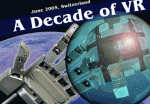
This new conference will seek input from a wider segment of the scientific community, and is interested in attracting experts in rehabilitation, disabilities, social science, cognitive science, as well as those interested in the meeting's core topics. There is also an interest in continuing to apply cutting edge technologies such as shared virtual worlds, avatars, video game virtual reality (VGVR), augmented reality, force feedback methods, and non-invasive physiological monitoring (heart rate variability, fMRI, PET, cardiac output, ultrasound and others) in virtual worlds.
This year's theme acknowledges the increasing use of interactive media in both training and therapeutic interventions (mental health, disabilities, and rehabilitation).
http://www.e-therapy.info/
Technologies include virtual reality simulations, telehealth, videoconferencing, the Internet, robotics, and non-invasive physiological monitoring devices. By utilizing technology for training and therapy, we are able to improve existing protocols, and disseminate care to a wider segment of the population.
13:32 Posted in Positive Technology events | Permalink | Comments (0)
Advanced Signal/Image Processing Techniques for Bioinformatics Call 4 papers
EURASIP Journal on Applied Signal Processing
Special Issue on
Advanced Signal/Image Processing Techniques for Bioinformatics
Call for Papers
The success of bioinformatics in recent years has been prompted
by the advanced signal processing technologies, in particular,
estimation theory, classification, pattern recognition, information
theory, networks, imaging, image processing, coding theory, and
speech recognition. For example, Fourier analysis methods are used
to elucidate the relationship between sequence structure and function;
wavelet analysis methods have been applied in sequence comparison
and classification; and various image processing methods have been
developed to improve microarray image quality.
The development of advanced high-throughput technologies, such as
genome sequencing and whole genome expression analysis, creates new
opportunities and poses new challenges to the signal processing
community. It provides an interesting application domain for signal
processing that analyzes data for life science problems such as time
series simulation and prediction, casual modeling, and structure
prediction. It is drawing a growing interest from the signal processing
community. The goal of this special issue is to present cutting-edge
signal processing methods with applications to bioinformatics. While
such research is of interdisciplinary nature, this special issue will
focus on computational aspects of bioinformatics research.
Topics of interest include (but are not limited to):
o Tracking in fluorescent imaging
o Protein folding and protein structure analysis
o Superposition methods for protein structure comparison
o Multiple 3D protein structure alignment
o Protein structure classification
o Protein secondary structure prediction
o Microarray image analysis
o Data mining from microarrays
o Sequence analysis
o Gene and regulatory signal discovery
o Biological system pathways and networks
Authors should follow the EURASIP JASP manuscript format
described at the journal site http://asp.hindawi.com/
Prospective authors should submit an electronic copy of their
complete manuscript through the EURASIP JASP's manuscript
tracking system at journal's web site, according
to the following timetable.
Manuscript Due May 1, 2005
Acceptance Notification September 1, 2005
Final Manuscript Due December 1, 2005
Publication Date 1st Quarter, 2006
GUEST EDITORS:
Xue-wen Chen, University of Kansas, Lawrence, KS 66045-7621,
USA; xwchen@ku.edu
Sun Kim, Indiana University, Bloomington, IN 47405-7000,
USA; sunkim@bio.informatics.indiana.edu
Vladimir Pavlovic, Rutgers University, Piscataway,
NJ 08854-8019, USA; vladimir@cs.rutgers.edu
David Casasent, Carnegie Mellon University, Pittsburgh,
PA 15213-3890, USA; casasent@ece.cmu.edu
13:20 Posted in Positive Technology events | Permalink | Comments (0)
Dec 17, 2004
Mitsubishi displays boost wearable computing market
Wearable displays allow the user to visually interface with the
omnipresent digital world whilst navigating their physical
environment. It's no exaggeration to say that the SCOPO could
very well be to the eye what the I-Pod was to the ear.
Wearable computing has been bandied about for many years
and many peripheral devices are trickling onto the market that
miniaturise the desktop model of interfacing (see Gizmo articles
http://gizmo.com.au/public/News/news.asp?articleid=3173,
http://gizmo.com.au/public/News/news.asp?articleid=3042, ).
The SCOPO, however, doesn't obstruct your field of vision like
some prototype displays. Instead it uses a small LCD screen that
hangs over your eye and fills your vision, providing the illusion of
a ten inch screen from a miniature surface. The headset has
optional headphones and a small belt carried unit that contains
the silicon that creates the images on the screen.
When plugged into a cell phone, PDA or laptop with video
functionality, you can stream directly to your field of vision or vice
versa, recording footage on the fly. The SCOPO belt unit does
not contain a hard drive for storing video or computing itself.
The SCOPO is expected to cost only US $400 and the initial
takeup is expected to focus on industrial and telecommunications
companies, as well as the personal user.
As a portable and affordable digital interface for your existing
PDA or mobile computer, the SCOPO promises real time data
feeds and information that can enhance your life whilst on the
move.
That gives you access to the full gamut of online resources,
whether GPS navigational maps, yellow and white pages data,
restaurant reviews and entertainment listings, or any text, voice
and image manipulation.
It also facilitates immediacy in that you can access your software
and data as you think about it, without having to reach for your
device. In fact, the easy access headset design allows the
SCOPO to be worn as a full time interface without interfering with
your daily activities.
With an industry leader like Mitsubushi releasing a cheap and
practical wearable display, substantial market penetration should
follow as well as new cultural trends. The street finds it's own
uses for things, and with the interaction of wearable displays with
wireless internet and other emergent technologies, the digital and
biological worlds are truly beginning to merge.
00:45 Posted in Wearable & mobile | Permalink | Comments (0) | Tags: Positive Technology, wearable
Dec 10, 2004
Virtual Reality in rehabilitation: the IREX system
IREX Exercise Applications
Virtual reality rehabilitation therapy applications enhance a patient’s rehab experience by immersing them in a virtual reality world. While in the virtual reality environment, the patient is motivated by seeing herself/himself engaging in various sports and games. This dramatically improves a patient’s focus and compliance to the activity in therapy.
Virtual reality sport and game environments aid clinicians in the development of exercise programs geared towards the creation of therapeutic treatment protocols.
13:30 Posted in Cybertherapy | Permalink | Comments (0) | Tags: Positive Technology, virtual reality
Dec 09, 2004
Positive Psychology
Martin Seligman and Mihaly Csikszentmihalyi describe this new field of research in the article: Positive Psychology: An Introduction
20:45 Posted in Meditation & brain | Permalink | Comments (0) | Tags: Positive Technology, meditation
Optimal Experience & Ambient Intelligence

In the chapter that I have recently published in the book "Ambient Intelligence", I present a framework to evaluate user’s experience in AmI systems that stresses the role of attention in actively selecting information from the digital environment. Being a limited resource, attention forces the individual to focus on a restricted number of environmental or internal stimuli per time unit. Therefore, each individual effectively perceives only a small part of the available information. This form of psychological selection is driven a positive, complex and rewarding state of consciousness, called flow, or optimal experience. Starting from these premises, in the second part of the chapter I explain how optimal user experience in AmI systems may be assessed. In particular, I describe the Experience Sampling Method, a procedure that has been effectively used in various applied research domains.
20:10 Posted in Pervasive computing | Permalink | Comments (0) | Tags: Positive Technology, Ambient intelligence
The Experience of Flow
Flow is an optimal experience characterized by:
* a sense of playfulness
* a feeling of being in control
* concentration and highly focused attention
* mental enjoyment of the activity for its own sake
* a distorted sense of time
* a match between the challenge at hand and one's skills
Info and Quotes from Flow: The Psychology of Optimal Experience By Mihaly Csikszentmihalyi:
"Contrary to expectation, "flow" usually happens not during relaxing moments of leisure and entertainment, but rather when we are actively involved in a difficult enterprise, in a task that stretches our mental and physical abilities." - Mihaly Csikszentmihalyi
"People seem to get more flow from what they do on their jobs than from leisure activities in free time." - Mihaly Csikszentmihalyi
It turns out that watching TV is not at all a flowful activity. People generally report higher levels of stress, depression, and tension after watching TV. It seems that TV's main virtue is that it occupies the mind undemandingly. Flow is hard to achieve without effort. Flow is not "wasting time".
"It is by being fully involved with every detail of our lives, whether good or bad, that we find happiness, not by trying to look for it directly. - Mihaly Csikszentmihalyi
"People who learn to control inner experience will be able to determine the quality of their lives, which is as close as any of us can come to being happy." - Mihaly Csikszentmihalyi
"Getting control of life is never easy, and sometimes it can be definitely painful." - Mihaly Csikszentmihalyi
"Since what we experience is reality, as far as we are concerned, we can transform reality to the extent that we influence what happens in consciousness and thus free ourselves from the threats and blandishments of the outside world." - Mihaly Csikszentmihalyi
20:00 Posted in Emotional computing | Permalink | Comments (0) | Tags: Positive Technology, experience computing
Neurotiv project
- Pervasive diffusion of intelligence in the space around us, through the development of network technologies towards the objective of the so-called “Ambient Intelligence” (AmI);
- Increasingly relevant role of mobility, through the develpoment of mobile communications, from the UMTS towards the so-called “Fourth Generation” (4G);
- Increase of reachness and completeness of communications, through the development of multimedia technologies, towards the “Immersive Virtual Telepresence” (TIV), including an increased attention to the aspects of human perception and of person-machine interaction.
The TIV perspective is reached through the complete development of multimedia technologies, generating far away the sense of presence through the integrated availability of sound, vision, smell, touch-and-feel (haptics) signals. Typically, the sense of presence is accomplished through multisensor stimuli by means of which actual reality is either hidden and substituted with a virtual reality, i.e. fully synthetic, or is virtualized, i.e. made virtual through audio and 3-D video analysis and modeling procedures.
The convergence of AmI, 4G and TIV technologies manifests itself as the next frontier of ICT. This convergence will determine the advent of ubiquitous 3-D telecommunications and the built-up of intelligent environments for health care in which complex multimedia contents integrate and enrich the real space. The most ambitious objective is to integrate the computer interfaces in the real environment (Mixed Reality) so that the user can take advantage of the clinical care in the most natural and intuitive way.
The Neurotiv Project aims at improving the know-how level, at generating new development and application opportunities, at organizing and finalizing multidisciplinary skills, and at developing system and component prototypes for the use of TIV technologies in a managed care system for neuropsychology and clinical psychology.
More in detail, the project aims at:
- proving the technical and clinical viability of integrating TIV systems in a managed care platform for neuro-psychology assessment and rehabilitation
- designing/tuning and developing managed care tools to be used in the prevention, planning provision and follow-up of the required treatment. The developed modules will be optimised to meet the demands of the emerging 2,5G/GPRS and 3G/UMTS wireless networks and terminals.
- Defining new treatment protocols for the use of the clinical tools in assessment, therapy and follow up.
- Verify the clinical economic/organizative efficacy of the managed care system by using controlled clinical trials.
- Disseminating the obtained results through scientific papers and conference presentations.
More to explore
The NEUROTIV project web site
19:50 Posted in Cybertherapy | Permalink | Comments (0) | Tags: Positive Technology, virtual reality, cybertherapy
EMMA project

This research will help to understand better the development of some psychopathological phenomena and the development of "new correcting experiences and learnings" to cope those psychopathological experiences.
Furthermore, EMMA project will pretend the development of innovative tools to be used with three different real users:
* users of (real world) mental health services, such as treatment for anxiety disorders, depression, and so on
* users with acute restricted mobility (e.g. designed experiences for hospital inpatients), and
* mood enhancement for general population (relaxation environments through TV or VR).
19:30 Posted in Cybertherapy | Permalink | Comments (0) | Tags: Positive Technology, virtual reality, cybertherapy
The VEPSY project
VEPSY is a European-Union funded research project for Telemedicine and Portable Virtual Environments for Clinical Psychology.
The project ended in July 2003. VEPSY-updated has involved partners from an international network of academic institutions and industrial companies.
The main goal of the project was to prove the technical and clinical viability of using portable and shared Virtual Reality systems in clinical psychology. 
The project has provided both innovative VR based tools for the treatment of patients, clinical trials to verify their viability and dissemination of its results.
In 2004 the VEPSY project won the Honourable Mention Award at the Europan e-Health Award 2004
18:45 Posted in Cybertherapy | Permalink | Comments (0) | Tags: Positive Technology, virtual reality, cybertherapy
New eDimensional VirtualFX Brings Mind-Blowing 3D to Your XBOX, PS2 and More
FROM THE PRESENCE-L LISTSERV:
New eDimensional VirtualFX Brings Mind-Blowing 3D to Your
XBOX, PS2 and More
Games Press 02/12/2004
(West Palm Beach, FL – December 2, 2004) eDimensional, the
leading manufacturer and worldwide distributor of cutting
edge gaming and virtual reality accessories, announces the
release of the new VirtualFX 2D to 3D TV Converter – bringing
a true virtual reality experience to your standard home
television.
At just $129.95 including 2 pairs of wireless 3D glasses,
eDimensional's new VirtualFX instantly converts any existing
video game into a mind-blowing 3D experience, giving players
the most lifelike gaming environment ever created – literally
putting them inside the game. Fighter planes seemingly buzz
by just inches away, racecars zoom at awesome velocity, and
First Person Shooters are suddenly a battlefield reality.
In addition to enhancing the gaming experience, the
proprietary E-D technology can also be used to watch DVDs and
even live TV in real 3D on a standard television (plasma, LCD
and projection screens are not supported).
"Our E-D 3D Glasses for the PC have been extremely popular
for years, but our recent breakthrough allows us to finally
bring that same amazing 3D effect eDimensional is known for
to the TV." explains Michael Epstein, president of
eDimensional. "With our new VirtualFX we are revolutionizing
the home entertainment experience – more interactivity, more
immersion, more realistic graphics and more exciting effects
– giving gamers and movie-watchers alike a truly mind-blowing
3D experience."
The VirtualFX package comes complete with two pair of
wireless 3D glasses, one converter box and a remote control.
Installation of the VirtualFX is a snap and is hooks up just
as easily as a regular DVD player. A dual-emitter transmitter
is utilized to give the widest viewing angle and range
possible and to beam a signal to perfectly synchronize the
refresh rate of the screen with the glasses. This
transmission also allows for additional users who have their
own pair of wireless glasses which can be purchased
individually for just $25.
The VirtualFX is available now through www.eDimensional.com.
As a bonus offer for the holidays, eDimensional is including
three 3D IMAX DVDs (A $60 value), originally shown in IMAX
theaters and specially made for exceptional 3D effects.
About eDimensional
eDimensional was founded in 2000 by a group of gamers at
heart, dedicated to creating the most realistic gaming and
entertainment experience ever. Thanks to fantastic customer
feedback and swift success, eDimensional has grown rapidly
and emerged as the leading manufacturer and worldwide
distributor of cutting-edge gaming accessories.
eDimensional's flagship product, the E-D 3D Gaming System,
was released to critical acclaim, and has since received an
unprecedented number of awards and accolades for providing
the most realistic PC viewing experience. For more
information on eDimensional and its wide array of gaming
accessories, go to eDimensional.com.
18:40 Posted in Cybertherapy | Permalink | Comments (0) | Tags: Positive Technology, virtual reality
Using VR to help children with motor impairments
Local children reach into virtual world
Students’ study hopes to help kids with motor impairments
By Shayna Garlick / Staff Writer
December 02, 2004
Seven-year-old Jewell Payne was in a virtual castle. Five blocks of different colors floated in front of her, and when she extended her hand and touched one, it disappeared. After a few minutes she had completed the exercise, and she removed her goggles to come back to reality.
Payne is one of 20 to 25 children who organizers hope will participate in this virtual reality game this semester, as part of research being conducted by Carole Dennis, chair of the occupational therapy department, and Sharon Stansfield, assistant professor of mathematics and computer science. Next semester, Dennis and Stansfield hope to have up to five children with cerebral palsy play the game, so they can evaluate its success as a treatment method for children with motor impairment.
The study allows technology that was first designed by Stansfield and computer science students in the summer of 2003 to finally be put to use.
Dennis said the study will help them compare movement in the real world and in the virtual world. Children participating in the research complete three sets of tasks, one in the real world and two in the virtual world.
In the “real world” game, a white board with five foam blocks of different colors attached to it is placed in front of the child. A computer mouse is placed on the child’s knee. When instructed to touch a block, he or she clicks the mouse, touches the block and then clicks the mouse again. The child does this for the other four blocks and repeats the exercise about five times. Sensors taped to the child collect data on the distance, speed and time it took him or her to go through each motion.
The child then puts on the virtual reality goggles and completes these sets of movements in two different virtual worlds. In both of these, the child will be inside a castle with blocks floating on the wall. However, the difference lies in what happens to the blocks once the child touches them. In one set of tasks, the blocks will turn in to something fun for the child, such as an alien or Mr. Potato Head. In the second virtual world, the blocks will simply disappear.
Studies have shown that when a task is more meaningful for a person, their motor control tends to better, Dennis said. She said they will be looking to see if movements are smoother and faster in the more exciting virtual world than the one in which the blocks just disappear. She is particularly interested in helping children with hemiplegia, a type of cerebral palsy in which one side of the body is stronger than the other. She hopes to set up games with which these children can use their stronger side and won’t have to work too hard to make interesting things happen.
She also hopes this motivation factor can be reverted back to the real world. For example, once researchers can analyze how a child with cerebral palsy reaches for the blocks in the real world, the child can practice that in game format and then go back to the real world again. Observers can look to see if the child’s performance has improved, Dennis said. Dennis and Stansfield said they are unsure of the outcome of the research because this is the first time this kind of virtual reality research has been conducted. Although they predict that the children will work harder in and enjoy the virtual world more, they are less certain it will actually improve their motor abilities.
The study is a multidisciplinary project, combining computer science and occupational therapy. Evan Suma, a senior computer science major, started work on this project a year ago. He said aside from the technical skills, he has also learned how difficult completing multidisciplinary research can be. “You’re talking different languages, and you have to sort of translate and figure out how to create something that will meet the goals of someone who speaks a totally different language than you,” he said.
Eight occupational therapy graduate students are also working on the study as part of a group research course. Senior Jessica Danow said she learned how much really goes in to a research project.
“I think its always great working with real people and doing something that’s the beginning steps of something that’s really going to make a difference,” she said.
18:35 Posted in Cybertherapy | Permalink | Comments (0) | Tags: serious gaming









